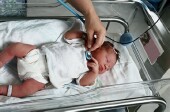
MONDAY, April 12 (HealthDay News) — An eye exam can identify premature infants who are most likely to benefit from early treatment of a vision-threatening eye condition called retinopathy of prematurity (ROP), a new study shows.
The benefit of early treatment for certain infants continues through six years of age, according to long-term results from the Early Treatment for Retinopathy of Prematurity study, which included 370 children.
ROP, which affects about 15,000 premature infants born each year in the United States, is one of the most common causes of vision loss in children. About 90 percent of infants with ROP have a mild form that doesn’t require treatment, but the severe form can lead to lifelong vision impairment or blindness.
Retinal detachment caused by abnormal blood vessel growth is the main cause of visual impairment and blindness in ROP. Laser therapy or cryotherapy (use of freezing temperatures) are the most effective ways to slow or stop the growth of abnormal blood vessels in the eyes.
“The long-term study has given clinicians evidence that infants with ROP should be treated with different strategies based on an infant’s risk for a severe form of the disease, which can be determined through an exam at the bedside,” study chair Dr. William V. Good, of the Smith-Kettlewell Eye Research Institute in San Francisco, said in a news release.
“This study has set the standard of care for infants with ROP by showing that early treatment of selected high-risk premature babies has positive longer-term results on vision,” U.S. National Eye Institute Director Dr. Paul A. Sieving said in the news release. The NEI supported the study.
The study appears online April 12 in the journal Archives of Ophthalmology.
More information
The National Eye Institute has more about retinopathy of prematurity.

